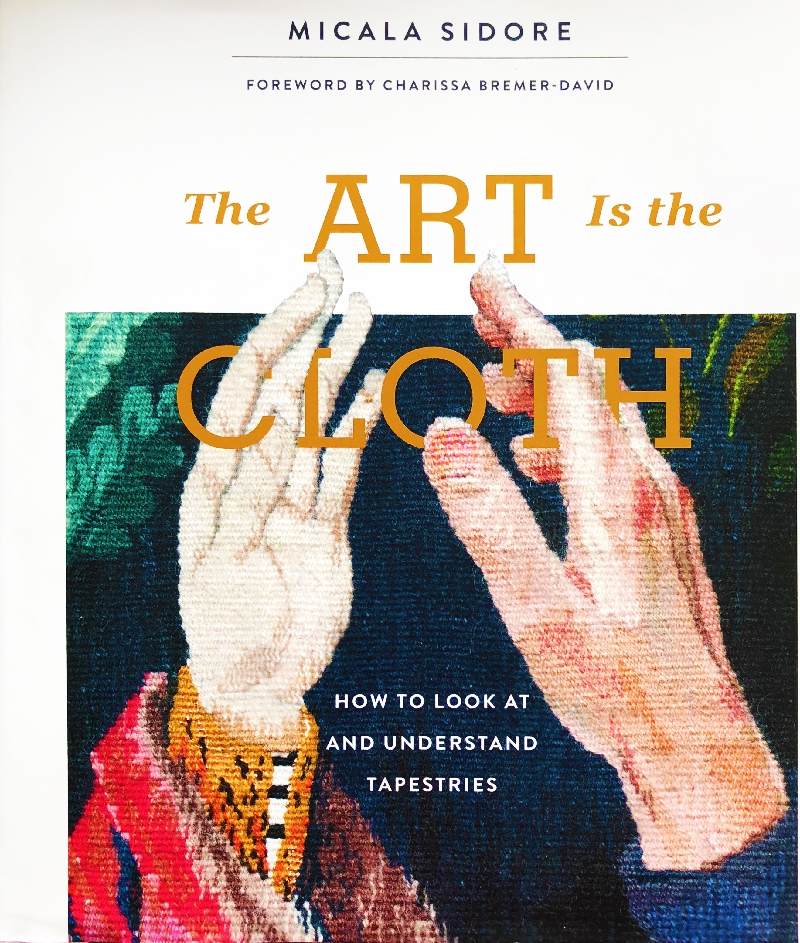 The Art is the Cloth: How to Look at and Understand Tapestries (Die Kunst ist aus Stoff – Wie man Wandteppiche sehen und verstehen kann ); Micala Sidore, Schiffer Publishing, USA, 2020; 223 Seiten, 620 Farb- und 4 Schwarzweißfotos, Preis 45 US-Dollar, englisch
The Art is the Cloth: How to Look at and Understand Tapestries (Die Kunst ist aus Stoff – Wie man Wandteppiche sehen und verstehen kann ); Micala Sidore, Schiffer Publishing, USA, 2020; 223 Seiten, 620 Farb- und 4 Schwarzweißfotos, Preis 45 US-Dollar, englisch
Micala Sidore ist selbst eine Tapisserieweberin, die mit der Herstellung dieses Buches begann, nachdem sie eine gleichnamige Wanderausstellung mit Wandteppichen von 60 Webern aus Kanada, Mexiko und den USA organisiert hatte. Dies ist ein überraschendes Buch, nicht nur wegen der vielen hier gezeigten Webkünstler, sondern auch wegen der ungewöhnlichen Art und Weise, wie sie zusammengestellt wurden. Sowohl die alten wie die neuen Tapisserien sind in neun Kapiteln angeordnet, wodurch die Leser mitbekommen, was Tapisserieweber in ihrer Kunst suchen. Die Webkünstler, über die wir hier sprechen, sind zu einem großen Teil die der neuen weltweiten Tapisseriebewegung, die nach der australischen Tapisserieausstellung “World Tapestry Today” entstanden ist. Diese Ausstellung wurde von der American Tapestry Alliance in Zusammenarbeit mit dem Victorian Tapestry Workshop organisiert. Sie tourte 1988/89 in Australien, Europa und den USA und wurde 1988 vom Symposium “Tapestry Today” in Melbourne begleitet. Sie war Ausdruck einer globalen Neuausrichtung – von den Künstlern selbst gewebte Tapisserie. Die Persönlichkeit des Tapisseriewebers Archie Brennan spielte in dieser Bewegung eine wichtige Rolle.
Micala Sidore erwähnt diese Bewegung nicht als solche, aber sie gibt einen vollständigen Einblick in das, was diese Weber umtreibt, oft illustriert mit Beispielen berühmter historischer Wandteppiche. Sie bespricht kurz technische Fragen in Kapitel eins. Die folgenden acht Kapitel zeigen Wege auf, was Tapisserieweben mit der Kunst des Stoffgestaltens zu tun hat. “Ich habe durchweg versucht, viele Variationen in diese Kategorien aufzunehmen”, schreibt die Autorin. Die Kapitel sind:
1. Grundelementen des Webens
2. Spezielle Materialien
3. Visuelle Themen, Anpassung der Vergangenheit an die Gegenwart
4. Trompe-l’œil
5. Direktionalität
6. Textilien und Identitäten, wenn Textilien eine bestimmte Gruppe definieren
7. Selbstreferenz
8. Historische Selbstreferenz
9. Kunst im Stoff
Um einige Beispiele zu nennen, beginnt das Kapitel “Spezielle Materialien” mit Rosshaar, das von den Burjaten aus Sibirien verwendet wird, und erwähnt dann Eisen und Kupfer, das von zeitgenössischen Künstlern in Tapisserien verwendet werden, sowie andere Materialien wie Perlen, Abzeichen und so weiter. Kapitel 3. enthält einige Beispiele für jahrhundertealte Verduren- und Millefleur-Wandteppiche und ihre modernen Variationen von Künstlern auf der ganzen Welt. Auf diese Weise behandelt der Autor alle neun Kapitel und enthüllt so einen Insider-Blick auf Tapisserie.
Diese Art, das Buch zu organisieren, ist frisch und inspirierend, nicht nur für Neulinge, sondern auch für diejenigen, die dieser Kunst seit langem zugetan sind. Abgesehen davon, wie die Kunstwerke in diesem Buch angeordnet sind, war ich gleichermaßen beeindruckt von der Anzahl der in diesem Buch gezeigten Künstler (238), viele natürlich aus Nord- und Südamerika, aber auch viele aus Europa und anderen Teilen der Welt. Dies mag an der Tatsache liegen, dass Micala Sidore ihre Ausbildung an der Manufacture Nationale des Gobelin in Paris erhalten hat und sie außerdem eine Person mit einer breiten Sichtweise ist, die es gewohnt ist, weit zu reisen.
Aus Europa habe ich zum Beispiel den Wandteppich “Opus 1: Persische Variationen” von Antje und Ulrich Müller-Reimkasten angetroffen, einen Wandteppich, den ich sehr bewundere, aber noch nie in einem Buch gesehen habe. Auch die “Sieben Marias” von Andrea Milde haben in diesem Buch einen wohlverdienten großen Platz, ein Werk das meines Wissens nur in Ungarn und in Litauen gezeigt wurde. Woher wusste die Autorin das?
Der Titel dieses Buches stammt aus einem Fax-Text von Helena Hernmarck an die Autorin, eine weitere Ikone der neuen Tapisseriebewegung, in der es heißt: “The Art is the Cloth” (Die Kunst ist aus Stoff / Kunst und Stoff sind eins). Archie Brennan selbst erinnerte seine Studenten wiederholt daran, dass Tapisserien letztendlich ein Stück Stoff sind! Diese einfache Tatsache, dass der Hintergrund des Kunstwerks und das Kunstwerk selbst ein und dasselbe sind, ist einzigartig für die Tapisserie. Micala Sidore hätte keinen besseren Titel finden können!
Unnötig zu erwähnen, dass ich dringend empfehle, dieses sehr schöne Buch zu kaufen, das den Lesern helfen kann, hinter die Kulissen der Tapisserieherstellung als Kunstform zu schauen!